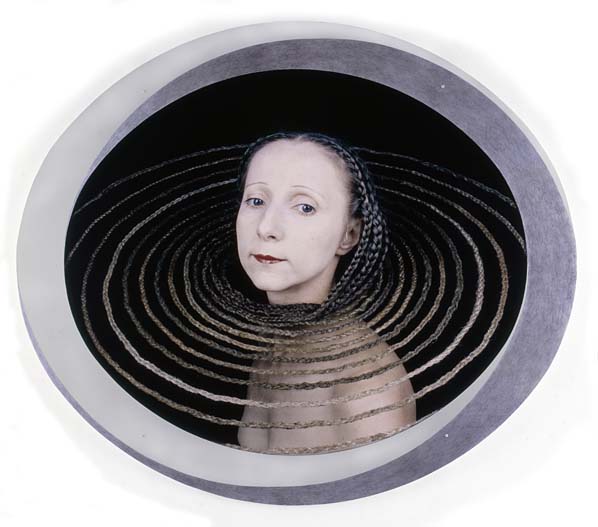
RIMMA GERLOVINA AND VALERIY GERLOVIN
PHOTOGLYPHS
© 2010, Rimma Gerlovina and Valeriy Gerlovin
PART 3
Staging our photographs, we've often utilized ordinary materials in an unordinary way, such as, for example, using hair as a medium. The extensive series of linear drawings made from braids explore the idea of projection beyond the self, as a personal wave of a trans-personal impulse. That anthropomorphic material assumes different guises, in some cases appearing as an antenna tuned to some unidentified frequency, or in others depicting an aura filled with live filaments.

| Rimma Gerlovina and Valeriy Gerlovin, Birth of Aphrodite, © 1992, C-print in aluminum frame, pencil drawing, 42 x 48". Collection of Nasher Museum of Art at Duke University, NC. |
Art can explore and extend both religious and mythological content in a remarkable way, even depicting the greatest events drawn by hair. From the braid series, Birth of Aphrodite (1992) and Madonna with Child (1992) attracted the most public attention; the latter was included in an art-history textbook. (4)
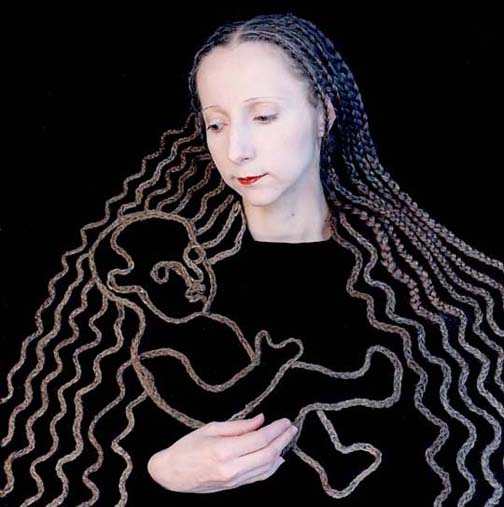
| Rimma Gerlovina and Valeriy Gerlovin, Madonna with Child, © 1992, C-print, 40 x 40". Collection of DZ Bank, Germany. |
In early Christianity, the child was associated with the birth of inner enlightenment, a sublime mystical being inside a personality. The mother and fetus are two and still one, while the child appears as an extension of the inner nature. Amid all kinds of wonders, it's a process of finding the articulation of the soul. The creative source acts in the particular moment and in the particular place, issuing force, time, and space out of the self. In a way, it's a child of itself. So we depicted the enchantment of creation by its own means, with hair braids. Apple Tree (1995) is another Gnostic version of the enduring theme of Our Lady, Seat of Wisdom. Holding an apple of knowledge with an "engraved" magic square on it, the figure is sitting atop the triune tree of life that grows out of her braids.
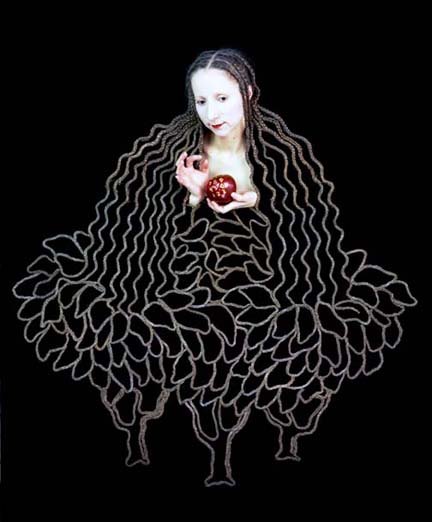
| Rimma Gerlovina and Valeriy Gerlovin, Apple Tree, © 1995, C-print. |
Perfect balance is rarely achieved between thoughts and feelings, between the magic square and the apple, between up and down. When the apple of knowledge falls on our "na-Eve" head, it pulls us down, until that knowledge of good and evil slowly grows into sapientia (one can ruminate on why the word "wisdom" has a feminine gender in Latin, as in Russian). With her snaky hair, the subject of Eve (1993/95) - designated "the Mother of All the Living" in the Book of Genesis - is like a tree of life with many codes and clues.
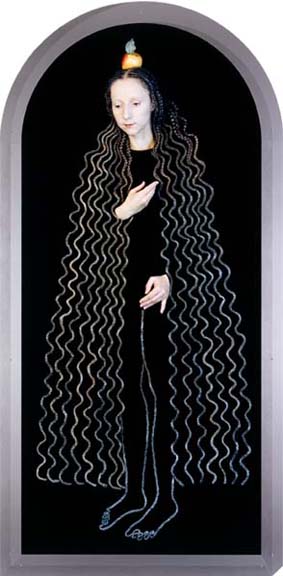
| Rimma Gerlovina and Valeriy Gerlovin, Eve , © 1993, C-print in aluminum construction with pencil drawing, 79½ x 39". |
Fate talks to our psyche by means of happenings, which language we have to learn involuntarily in order not to sink in the ambivalent circumstances of life. Each hero of his or her own drama experiences the outward blows of the providence, meanwhile Eden is just as good whether our destiny keeps us in or out of it. The first example of working of that life mechanism of displacement can be traced in the story of the first couple expelled from Eden because of their fall, or rather by reason of the course of the world. In Genesis all these consequences are related to the apple, the fruit of temptation and a gravitational divisive consciousness between duality (life and death, good and evil, pleasure and pain, etc.) As soon as we have Adam, cherchez la femme, and the path to this apple is ensured. To use the words of James Joyce,"the cutlet-sized consort" was brought forth from Adam's side. Supposedly, this downfall is for the sake of knowledge. But man must first know that he is ignorant before he can search for the knowledge.
Our apple from that tree fell on us in Russia, in the East, and was eaten in the West. In the autobiography behind this work there's the familiar pattern of the so-called myth of eternal return - the return to our motherland, but in a reversed way. Eve was included in the exhibition Faces of America by Contemporary American Artists (we became U.S. citizens in 1985), held in the American Embassy in Moscow in 1997-2001, which prompted an unusual excursion: in 2004, we were invited to the White House and the State Department for a banquet held in honor of the Art in Embassy Program.(5) Beyond the theoretical ideas embedded into these works, it's worth mentioning how the photographs functioned in the actual world. The retrospective exhibition Photoglyphs, hosted by the New Orleans Museum of Art, traveled to venues in fifteen cities from 1993 to 1999, attracting considerable press coverage.
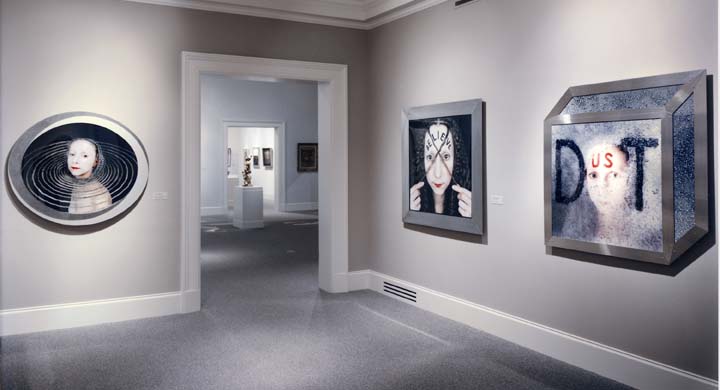
| Rimma Gerlovina and Valeriy Gerlovin, Installation view of the travelling exhibition Photoglyphs at the New Orleans Museum of Art, 1994. Left to right: Birth of Aphrodite, ©1992, C-print in aluminum frame, pencil drawing, 42 x 48"; Be-lie-ve, ©1990, C-print in stain-less steel frame, 48 x 48"; Dust, ©1990-91, C-prints in stainless steel construction, 48 x 48". |
The works were reproduced in various publications, sometimes on the covers of different magazines, including The New York Times Magazine, The Sciences, Zoom, or the book Art on the Edge and Over, devoted to radical trends in contemporary art. In addition, The New York Times Magazine featured our work in its Millennium Issue on art.(6) A review of a gallery showing of our work appearing in ARTnews described our artistic method vividly yet concisely: "The Gerlovins have reclaimed their faces, torsos, hair, and hands and made of these materials evangelical media... luminous and unmarked... emanating power."(7)
We've accepted the ebbs and tides in our artistic life without asking or forcing anything. Since moving from Manhattan to the countryside of upstate New York in 1993, we've lived in solitude. Naturally, in ebb time the difficulties pile up; we've often had to swim against the current, trying to take it in all stride with mental and emotional detachment and steadiness. With that, we now return to our main subject, leaving aside facts and details.
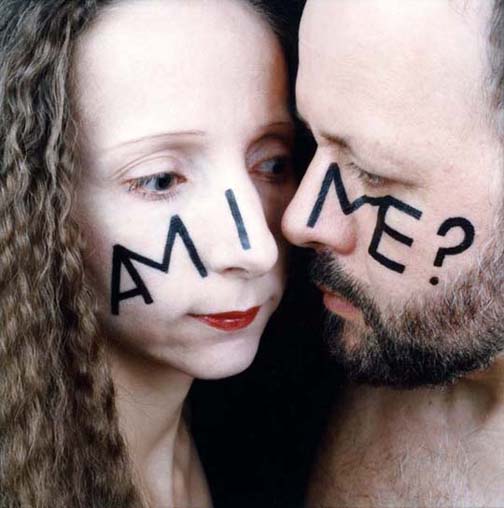
| Rimma Gerlovina and Valeriy Gerlovin, Am I Me? © 1991, C-print. |
Our pARTnership is a natural result of our coexistence, a complementary union of opposites. Working both together and separately, we seem to be one another. In photography, this state is articulated in the form of a question: Am I Me? The factor of the male/female union contributes much. Fused into a joint "receptacle" for the phenomenal world, it naturally increases the outcome. The union of opposites tends to produce something new - it begets. Therefore, our collective creative imagination synthesizes ideas from different realms, nurturing a new aesthetic offspring within ourselves. With the mixed blessing, the physical body of our photographs comes from the male side, or from his hands. The concepts come from the female side; she "infuses" the spirit.
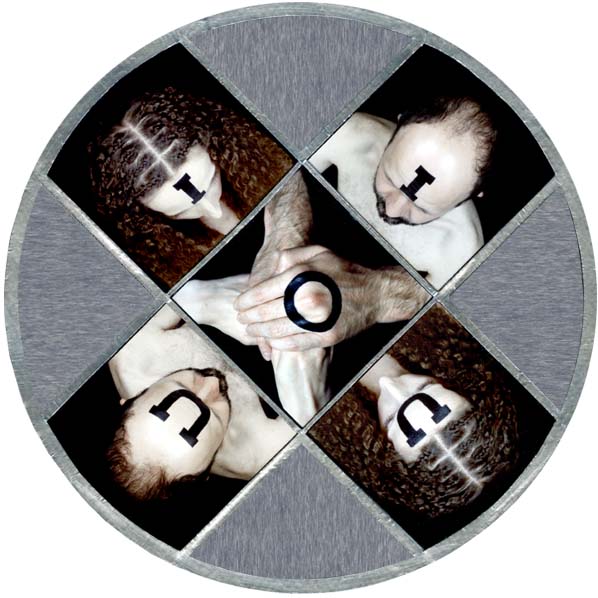
| Rimma Gerlovina and Valeriy Gerlovin, IOU, © 1989, C-prints in metal construction. |
The nature of our long-standing collaboration is faithfully expressed in IOU (1989). Based on the abbreviation for "I owe you," the composition depicts an intimate round table for two, the "quadrature of the circle." The central "O" is the androgynous zero point between the plus and the minus, between masculine and feminine dynamic symmetry. In different initiatic traditions, it was considered the point of immense force and wonderment. If we look to the ancient Egyptian mysteries of Isis and Osiris, tantra, or alchemy, we readily observe that all of them are based on the idea of a transcendental marriage of opposites. "When you make the two one... the inside like the outside... and the above like the below, and when you make the male and the female one and the same, so that the male not be male nor the female female... then will you enter the Kingdom," reads The Gospel of Thomas (§ 22).(8) The dynamic symmetry of opposites is maintained through the perpetual interchange that unites by dividing and gives by taking. But that must not be understood straightforwardly. Duality is just one aspect of unity. Anything is possible within a single individual whose mind "marries" his heart, uniting the mental with the intuitional.
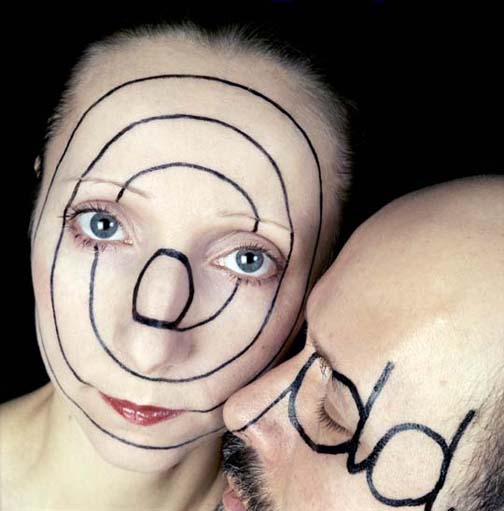
Rimma Gerlovina and Valeriy Gerlovin, Odd © 1989, C-print. Link to The Sackner Archive of Visual and Concrete Poetry featuring album Kniga-Book with the preparatory drawing of that work. |
Center of all things is infinite, therefore centerless. Odd, isn't it? This word pops-up like a spring, and its significance is greatly extended. The subject can be interpreted either, from the immediate proximity, or from the distance. From one point of view, it is just an oval drawing outlining the oval of the face; from another, the rings growing from the central letter "o" imitate the spiraling formation of a distant universe. What if we fuse both these characteristics? The face will appear as an eggshell of the universe, symbolizing the matrix out of which life emerges. For logically inclined mind, it can be zero, which is neither odd nor even. Pondering on the nature of transient, we raised another question concerning its reality.
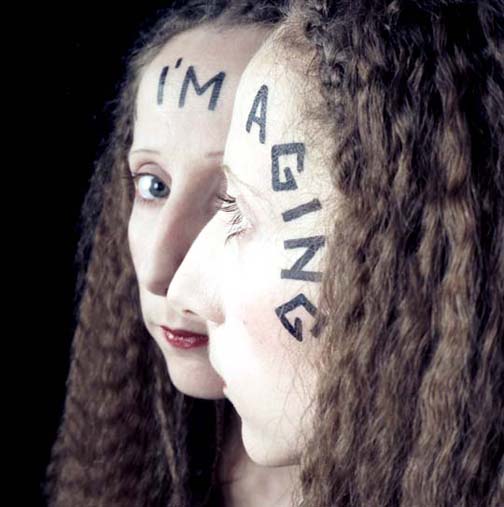
| Rimma Gerlovina and Valeriy Gerlovin, IÕmaging © 1989, C-print. |
The work depicts a double process: imaging and aging, tendency to atemporal and temporal modes of existence. The melting thoughts of the finite body awaken the imagination into a dual activity. There is nothing new in the notion that physical life is temporal and, in biblical terms, "lives according to the flesh," which "presseth down the mind." (9) Nobody can escape the inherent characteristics of our bodies chained into the complex of birth-grow-vigor-decay-death. In the material realm the elements change visibly, which is in contrast to the more subtle realms, where transformations occur intangibly and across different time spans. Time does not grow old. Our Imaging/ I'm aging plays somewhere in-between the territories of timelessness and time.
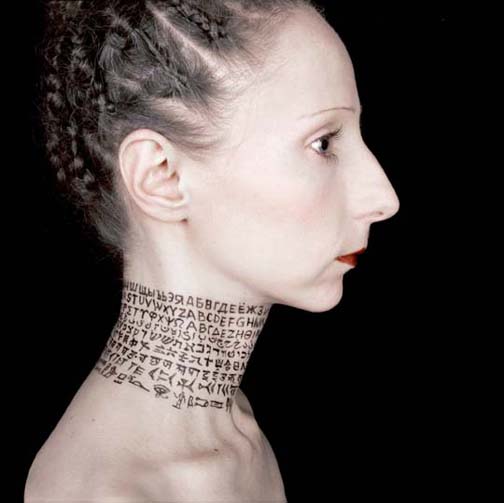
| Rimma Gerlovina and Valeriy Gerlovin, Neck of Alphabets © 1989, C-print. |
The same theme is developed in Neck of Alphabets but a different way: it is based on another set of timing measurements, linking classical aesthetics with the elements of linguistics and archeology. In the manner that the annual ring is embossed on the tree trunk, the alphabetical rings grow from foot to the crest of the neck. Starting from the oldest family of languages that sprung from the mists of time, it crowns the tree of languages with its youngest brunches in the following sequence: Egyptian hieroglyphics, Babylonian Cunei forms, Sanskrit, Chinese, Hebrew, Arabic, Greek, English, and Russian. Uniting verbal and visual interplay, this photograph retains a curious appearance of an artifact from a department of antiquity, resembling both some stele bearing an inscription and a limestone bust from the Egyptian necropolis. Certainly, it is not a chronicle of the evolution of writing on the rubbles of old languages and the repressed memories of humanity, but a figurative anthropomorphic tree of language families with the principal pattern - the innate capacity of the human brain for communication. More became apparent to us after time had forced us to dwell on its meaning.
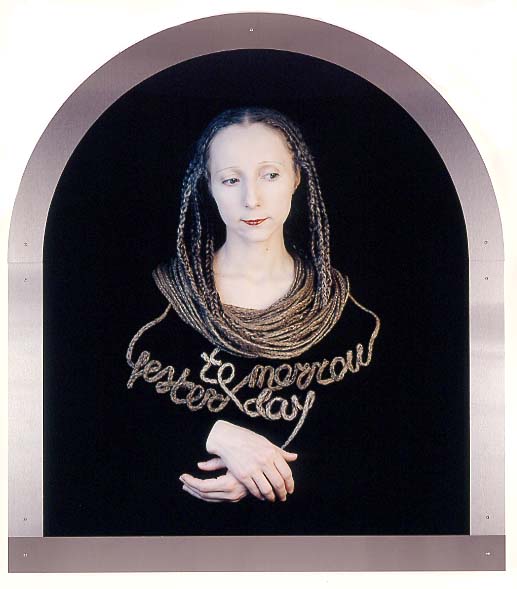
| Rimma Gerlovina and Valeriy Gerlovin, Today, © 1992, C-print in stainless steel construction, 47 x 42". "TODAY" is part of "TOmorrow" and "yesterDAY." |
Today is just a crosspoint of tomorrow and yesterday. Today is changing yesterday but is changed by tomorrow; everything is a seamless extension of everything else. The whole past of the Earth is nothing but an unfolded present. The weaving of braids here is symbolic of the spinning of destiny and time, attributed to the three Fates (Greek Moirae, or Latin Parcae). All three of them operate as one cohesive timer with three functions: the spinning of the thread of life, determination of its lot and length, and finally cutting its off. Like three Moirae, three Maries were present under the feet of the cross of matter, on which the spirit was tormented. In Today we fused the verbal expression with the silence of Moirae, who is calm and tranquil witness of the procession of time, which is photographically frozen within its three interdependent movements, existing simultaneously the day before, yesterday, today, and the day after tomorrow...
Here we encounter the old dilemma, whether we weave our web of destiny or we are only a part of the circumstances woven by it. "Character is fate,"- said Heraclites. The Buddhist catechism Dhammapada opens with the similar verdict: "All that we are is the result of what we have thought."(I, 1) In every moment of our life, we originate something that will be a part of our self in a future. Therefore, today is present in both yesterday and tomorrow in its overtone and undertone latency. Whether incarnated or not the real self is said to be everlasting, but how can we sift out the unreal from the real? "Turn inward!"- Advised the past masters. "But where is this in?" Entering the endless circle of inwardness "squared" by words, one tries to search for the golden mean between the two extremes, between cause and effect, weaving 4-strand braid:
living for a time living in time living out of time living beyond time |
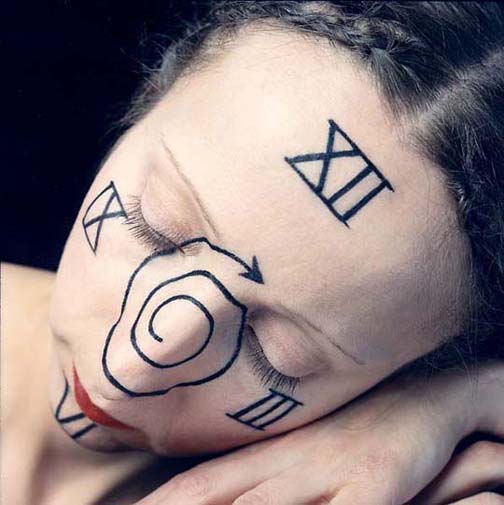
| Rimma Gerlovina and Valeriy Gerlovin, Spiral Clock © 1989, C-print. |
The Spiral Clock (1988) is one more sample of the concept divided between the objects and the photographic media. Rotation of the spiral clock's hand that counts no hours produces an effect of the vortex drawing everything towards its center. Time does not pass - all "whens" are now.
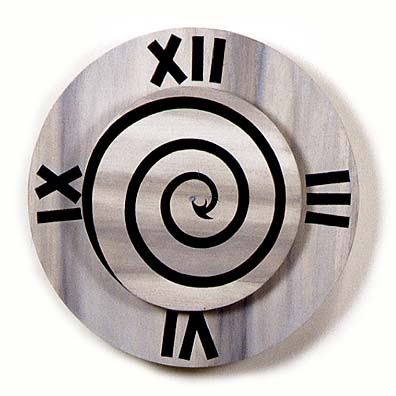
| Rimma Gerlovina, Spiral Clock, © 1988, plywood, acrylic, 17½ x 3". |
In the photographic version of The Spiral Clock (1989), the winding hand coils like a snake on the slumbering human clock face; it seems to freeze time inside the subject. People say that time runs out wild; maybe it stays where it is, and we are spinning around it. For men, his "now" immediately becomes the past as soon as it comes - at this very moment, and every moment of a moment. The "now" operates between "before" and "after," between our desires for the future and our memories of the past. That is a zero point, through which the plus and the minus are processed. What has passed, is passing, or is intended to pass is always present in that very moment. Having neither a beginning nor an end, the "now" cuts through the entire universe. It is a revolving door to and from eternity. According to some theories (both scientific and religious,) what had happened a thousand years ago, what is going to happen in a thousand years, and what is happening now, is all but a single act. Through that allotted to us "now" we see the world like through the aperture.
FOOTNOTES
1 Albert Einstein, The World As I See It (New York: Philosophical Library, 1949), 5.
2 Plutarch, The Face in the Moon (The Loeb Classical Library, 1957), Vol. XII, 95
3 The Divine Pymander of Hermes, translated by Dr. Everard (San Diego, CA: Wizard Bookshelf, 1985), The Fourth Book, Called The Key, §§ 39, 46, 93, pp. 24-30.
4 Lois Fichner-Rathus, Understanding Art, 8th ed. (Belmont, Calif.: Thomson/Wadsworth, 2007), 24, 32, 33. Also editions 5-9, 1987-2007. (The work Madonna and Child is cited along with Alexander Calder for the use of an unusual linear drawing technique, and described as "a revision of one of the most popular religious themes of the Renaissance.)

5 Faces of America by Contemporary American Artists, exh. cat. (U.S. Embassy in Russia, 1997-2001) and Art in Embassy Program 40th Anniversary (Washington, D.C.: U.S. Department of State, 2004).
6 The New York Times Magazine (July 7, 1996); The New York Times Magazine ("The Millennium Issue on Art") (September 19, 1999); Zoom (international, Japanese, and Russian issues) (May-June and July-August 2006); Sciences (May-June 1997); Linda Weintraub, Arthur Danto, and Thomas McEvilley, Art on the Edge and Over (Litchfield, Conn.: ArtInsights, Inc., Publishers, 1996).

7 Jean Lawlor Cohen, "Rimma Gerlovina and Valeriy Gerlovin at Robert Brown Gallery," ARTnews (April 1994), 175.
8 The Gospel of Thomas (22), The Other Bible (San Francisco, Calif.: Harper & Row, 1984), 302.
9 Romans (8:15) and Wisdom (9:15)
-----------------------------------------------
BIBLIOGRAPHY
Many Photoglyphs are reproduced in the books and the catalogs:
Thought of Thoughts, Book One: Believe, 2017, ISSUU
The Concepts, book,1012 (video) On ISSUU: Part 1 Part 2
Photoglyphs The New Orleans Museum of Art, 1993, (more...)
Still Performances, MIT, 1989.
Madonna with Child ©1992:
Book Moscow
Conceptualism in Context, ed. Alla Rosenfeld, the artists' essay
"Trespassing", Prestel, 2011.
Eve ©1993:
Bill Moyers,Genesis. A Living Conversation Channel 13 and Doubleday, 1996.
Art Cartier ,"Russia", English, French, and Russian editions, #17, 2007.
Grace Glueck "Nyet to Pass é Soviet Realism...", New
York Times, Dec. 05, 2003.
Bird © 1989:
Russell Joslin, Interview
with Rimma Gerlovina and Valeriy Gerlovin, Shots magazine, #89, fall, 2005, back cover, pp.38-45,
Calendar ©1989:
Annual Report, The Progressive Corporation 1996.
Echo ©1989:
Narcissism. Artists Reflect Themselves, California Center for the Arts Museum, Escondido,
CA, 1996 (more).
Am I Me? ©1991:
New York Times Magazine, 7.7. 1996.
Romulus
and Remus ©1989:
"Photoglyphs", The New Orleans Museum of Art, 1993, cover, (more).
GENERAL LINKS:
|
Art Institute of Chicago Collection, Chicago, IL Collection of Nasher Museum of Art at Duke University, NC.
The New York Times Magazine, The Millennium issue
|